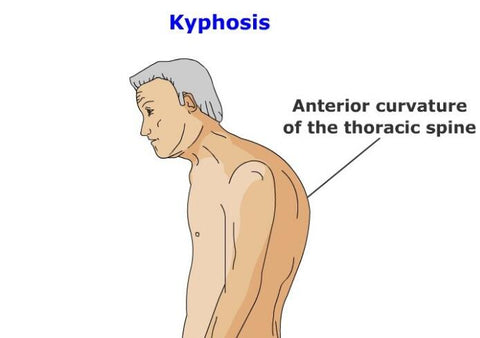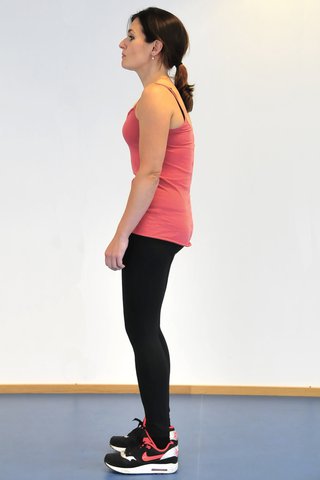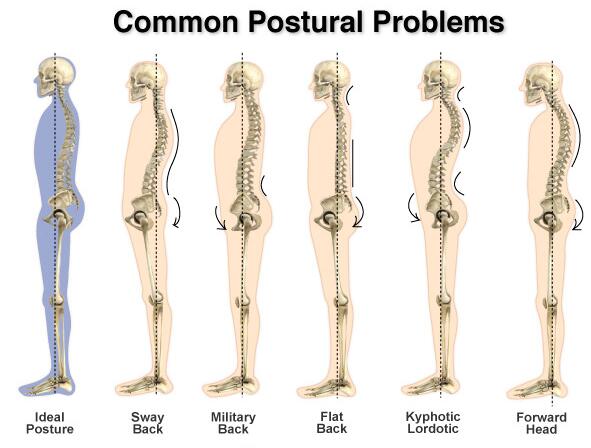1.Hunched Back (Thoratic Kyphosis)

Hunched Back, technically called thoratic kyphosis, in which condition the spine in the upper back has an excessive curvature. The upper back, or thoracic region of the spine, is supposed to have a slight natural curve. The spine naturally curves in the neck, upper back, and lower back to help absorb shock and support the weight of the head. Kyphosis occurs when this natural arch is larger than normal.
Cause
Kyphosis rarely occurs in newborns because it’s usually caused by poor posture. Kyphosis caused by poor posture is called postural kyphosis.
Other potential causes of kyphosis include:
- aging, especially if you have poor posture
- muscle weakness in the upper back
- Scheuermann’s disease, which occurs in children and has no known cause
- arthritis or other bone degeneration diseases
- osteoporosis, the loss of bone strength due to age
- injury to the spine
- slipped discs
- scoliosis, or spinal curvature
How To Treat
- Stand up straight and tall
- Keep your shoulders back
- Pull your stomach in
- Put your weight mostly on the balls of your feet
- Keep your head level
- Let your arms hang down naturally at your sides
- Keep your feet about shoulder-width apart
- Try a posture back brace that fits you
2.Forward Head Text Neck

Text neck is a Modern age term coined to describe repeated stress injury and pain in the neck resulting from excessive watching or texting on hand held devices over a sustained period of time. It is also often known as Turtle Neck posture. It is a cause for increasing concern especially with children given their greater propensity to mobile phone usage. Recent figures have shown that around 87% of teenagers (14-18 years) in USA and 79% teenagers (12-15 years) in UK own and use smartphones. Among adults 92% and 95% (18-34 years) reported owing a smartphone in USA and Australia respectively.
The term 'Text Neck' was coined by Dr. DL Fishman, a US chiropractor.This condition is a growing lifestyle and health condition with the constant growth in mobile user population all over the world. Apart from neck pain, it can also cause shoulder pain, upper back pain, headaches and increased thoracic kyphosis.
Symptoms
Flexing the head forward to use a smartphone affects the spine directly. Tilting the head forward to 15 degrees places about 27 pounds of force on the neck. This increases to 40 pounds at 30 degrees, 49 pounds at 45 degrees and 60 pounds at 60 degrees. Damage caused by untreated text neck can be similar to occupational overuse syndrome or repetitive stress/strain injury.
The most common presentation of Text Neck is neck pain, stiffness and soreness. The main symptoms include
- Stiff neck: soreness and difficulty in moving the neck is usually present when trying to move the neck after long usages
- Pain: can be localized to one spot or may be diffused over an area, usually lower part of the neck. Can be described as dull aching or can also be sharp or stabbing in extreme cases
- Radiating pain: there can often be radiation of pain into the shoulders and arms.
- Muscular weakness: shoulders muscles namely, trapezius, rhomboids and shoulder external rotators are often weak
- Headache: sub-occipital muscle tightness can lead to tension type headaches.
Treatment:
Prevention is the key when it comes to Text-Neck. Following suggestions should be kept in mind while using smartphones or other hand held devices:
- Avoid excessive usage and take frequent breaks
- Avoid prolonged static postures
- Position the device such that it reduces stresses both on the head/neck and the upper extremities
- Avoid high repetitions of movements such as prolonged typing or swiping
- Avoid holding large or heavy devices in one hand for long duration
- Try a posture back brace that fits you
3.Flat Back

The spine of the human body has its own natural curves. Now, when you look at the spine from behind then it would look straight with its center over the pelvis but when you look at the spine from the side you can see a distinct curve which the spine requires to maintain balance as it is located behind organs like the chest and the abdomen. Normally, the spine has two curves which give it an “S” shape. In the neck, there is an inward curve whereas in the thoracic and lumbar spine there is an outward curve. The inward curve is called as lordosis and the outward curve is called as kyphosis. These curves normally balance out each other so that when an individual stands he or she is well balanced and does not fall and even walk and run without falling.
4. Sway Back

Sway back posture — casually known as the ‘lazy posture’, is identified by shoulders and chest leaning backwards, with hips turned in and pelvis and chin thrust forward. This posture is usually due to a lack of support for the hips and pelvis, hinging at the back, thereby applying immense pressure on the lower back, leading to pain. Weak abdominal muscles also contribute to the problem, as these muscles function to bring the upper body forward. Those with weak buttocks, quads and lower abdominal muscles; people who adopt this posture often find themselves needing additional external support, such as a wall or other grounded objects to lean against. The sway back posture is almost the antithesis to the flat back posture.
5. Lumbar Lordosis

Lumbar hyperlordosis is a condition that occurs when the lumbar region (lower back) experiences stress or extra weight and is arched to point of muscle pain or spasms. Lumbar hyperlordosis is a common postural position where the natural curve of the lumbar region of the back is slightly or dramatically accentuated. Commonly known as swayback, it is common in dancers. Imbalances in muscle strength and length are also a cause, such as weak hamstrings, or tight hip flexors (psoas). A major feature of lumbar hyperlordosis is a forward pelvic tilt, resulting in the pelvis resting on top of the thighs.

